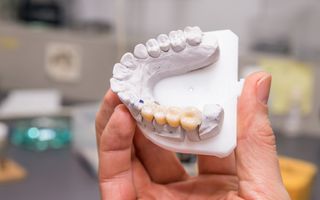
Do you have one or more missing teeth that are impacting the way you eat, speak or smile? Look no further than National Dental Care Algester.
We understand the importance of a healthy and complete smile. That’s why we offer quality dental bridges to restore the look and functionality of your teeth.
Book a consultation with our team in Algester to find out how you can regain your smile and improve your oral health with a dental bridge.
What is a dental bridge?
A dental bridge fills the gap between two teeth using false teeth. Unlike a dental implant, it doesn’t need to be implanted into the jaw. Instead, the bridge connects a false tooth to the natural teeth on either side of the gap.
Dental bridges are a great alternative to dental implants, whether you simply don’t want one or your gums or jaw are not in good enough condition to receive an implant. Dental bridges can be made up of metal, porcelain, zirconia, or a combination of any of the three.
There are three types of dental bridges:
A traditional bridge is the most common type of dental bridge. It involves placing dental crowns on the teeth that sit on either side of the gap and attaching a ‘pontic’ (a false tooth) between them.
A cantilever bridge is less common. When there is only one tooth next to the gap, the dentist will place a crown over that tooth and attach the pontic to it. However, this method is less stable than attaching the pontic on both sides, which is why it’s not recommended for back teeth that bear a lot of pressure.
The Maryland bridge style is named after the University of Maryland where it was invented. It’s similar to a traditional bridge, where a false tooth is attached to the teeth on each side of the gap. However, instead of using crowns, it uses 'wings' that attach to the back of each tooth next to the gap. It is important to note that this style is not recommended for back teeth and is only suitable for people with good oral health.

Dentist holding a completed dental bridge ready for application
No matter the style, a dental bridge at National Dental Care Algester can help to give you the full functionality of a full set of teeth and restore your smile. If you have a gap in your teeth and think a dental bridge might be right for you, National Dental Care Algester has the skills and experience to make it happen.
The pros and cons of dental bridges
The pros of a dental bridge:
- Non-Surgical Alternative: Dental bridges are an alternative to invasive dental implants, which involve anchoring the tooth to the bone beneath the gum line. This may not be suitable for everyone, especially those with underlying gum or jaw issues.
- A Complete Smile: Missing teeth can impact your confidence and make you feel self-conscious about your smile. A bridge fills the gap left by missing teeth with a natural-looking solution.
- Restored Functionality: A dental bridge offers full functionality, meaning you’ll be able to eat, drink, and talk normally.
- Improved Oral Health: A missing tooth can cause your other teeth to deteriorate faster, as well as leading to tooth movement. A dental bridge can prevent this, resulting in better dental health.
The cons of a dental bridge
- Invasive for Adjacent Teeth: Traditional bridges sometimes require crowns to be placed on healthy adjacent teeth, which may involve reshaping and covering them. This can lead to the removal of some healthy enamel and potentially cause harm to teeth that were initially in good condition.
- Risks with Maryland Bridges: Maryland bridges, while less invasive, can damage existing teeth due to the removal of enamel at the back of the teeth. They are also less resilient to chewing pressure compared to other bridge types.
- Ineffectiveness Against Bone Loss: When a tooth is missing or removed, the jaw bone that previously supported it can start to deteriorate. Unlike implants, which have an artificial root anchored into the jaw bone, bridges sit above the gum line and don’t have roots. As a result, bridges don’t prevent bone loss like implants do.
- Limited Longevity: Dental bridges may not last as long as implants. A dental bridge will only last as long as the teeth that support it.If there are problems with these teeth in the future, such as decay or gum disease, the bridge will be compromised.
It's important to think about both the advantages and disadvantages when considering whether a dental bridge is the right choice for you. Your dentist at National Dental Care Algester can provide further guidance based on your individual circumstances.
What to expect from a dental bridge treatment
From start to finish, here’s what’s involved in a typical dental bridge procedure at National Dental Care Algester:
- Have something to eat and drink before the procedure so you don’t get hungry
- Brush and floss your teeth
- Your dentist will start by applying a local anaesthetic to numb the area
- They will then remove a thin layer of enamel from the two abutment teeth
- Next, your dentist will take impressions or digital scans of your teeth to send to the lab
- This first appointment will finish with the dentist adding a temporary bridge to protect your teeth until you receive the permanent bridge
- Your next visit will occur approximately 2-4 weeks later, or whenever your custom-made bridge is ready
- Your dentist will again start by numbing the area with local anaesthetic
- They will remove the temporary bridge
- Next, they will test the fit of the permanent bridge
- If it fits well, they will fix it in place with dental cement
- Finally, they will shape the dental crowns and bridge to suit your bite
- The area will likely remain numb for several hours following the procedure
- Your dentist will check on the bridge during your next appointment
Are you looking to restore your smile? Discover the potential benefits of our dental bridging service at National Dental Care Algester. Regain functionality with our carefully crafted dental bridges. Contact us to schedule a consultation and begin your journey toward smile restoration.
Frequently asked questions
The cost of a dental bridge will vary depending on the type of bridge you get and the materials used, as well as some other factors.
At National Dental Care Algester, your dentist will be able to give you a more accurate estimate once they have a better idea of your situation and oral health.
Keep in mind that your insurance may pay for some of the treatment, so it’s worth checking with your provider.
Health Funds: At National Dental Care Algester, we aim to make dental care accessible to everyone. That’s why we partner with leading health funds to help you manage your dental costs. By working closely with major health fund providers, we make it easy for you to use your dental benefits and claim rebates directly at our clinic.
Payment Plans: To help you manage your dental expenses with ease and convenience, we also offer two payment plans - SmileFund and Afterpay.
SmileFund provides personalised payment plans designed specifically for dental treatments, making it more affordable to get the care you need. Meanwhile, Afterpay lets you split your dental costs into interest-free instalments, making it easier to get a healthy smile without breaking the bank.
With good care and regular check-ups at National Dental Care Algester, about 90% of dental bridges are still in place 10 years later. You will need to avoid biting down on very hard and very sticky foods to minimise the chance of breaking the bridge or even pulling it off. You will also need to maintain good dental hygiene to keep your natural teeth and gums strong, as these support the bridge.
Absolutely! Unlike dentures, Dental bridges are permanently fixed to your existing teeth, and cannot be removed without damaging them.
